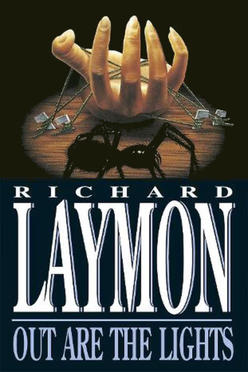Out Are the Lights

In a small California town, the Haunted Palace cinema specializes in horror films. Between showings of The Hills Have Eyes and The Texas Chainsaw Massacre, they play exclusive shorts featuring madman Otto Schreck. But unbeknownst to the audience, the horrific murders in these grainy films are real.
Laymon’s third published novel juggles multiple disparate points of view. There’s deaf author Connie and her live-in boyfriend Dal. Dal’s heading out for a movie at the Haunted Palace. Connie hates horror movies, so he’s going by himself. Connie, insecure, resents him for leaving her alone. Her suspicions have merit, as Dal drives past the theater to rendezvous with Elizabeth, a woman he met earlier that day.
Cut to the Haunted Palace, where we meet Pete Harvey, a private investigator, and his date Brit. They watch the movie and the attached Schreck short. Despite the dubbed voice, Brit thinks she recognizes one victim as Tina, her former roommate.
Meanwhile, Connie, frustrated and nervous, walks down to the neighborhood Seven-Eleven. Feeling invigorated, she continues into town, where a carful of men assault her. Connie fights back, flooring the would-be assailants, and steals their car, which she torches in a deserted parking lot.
The next day, Brit phones Tina but gets Freya, Tina’s roommate. Freya tries to put Britt off, but Britt persists, drives out, and shows up on Freya’s doorstep.
I’ll stop there. There are more characters, but we don’t get inside their heads. Laymon does proffer POVs for the characters in the short films, which he treats like flash fiction stories.
Despite this large cast, Laymon maintains a brisk narrative momentum via his usual use of simple sentences and action-based description.
He parked. He climbed from his car. He walked toward the door. He reached toward the lighted doorbell button.
Notice how he introduces the door and doorbell with action.
Another example:
She drove forward. The road curved into a thickly wooded area. She stopped at a metal gate, opened its padlock, and swung the gate wide. After driving through, she shut the gate and snapped its lock into place.
Laymon also shows a deft hand crafting action sequences. Consider this scene:
Shovel clutched to her chest, she threw herself head over heels, hit the grass, twisted around and jammed the handle to the ground. Schreck, unable to stop, ran against the shovel blade. The shaft jerked in Connie’s hands. She yanked it, throwing Schreck overhead. He hit the ground and rolled. She rushed him. She raised the shovel high and crashed it down on the back of his head.
Despite this craft, Out Are the Lights feels disjointed, as though Laymon struggled between writing a much longer, darker book, and this shorter—almost novella length—EC Comics style story with its poetic justice ending.
Said ending surprises with its abrupt arrival, and would have torpedoed a longer read. Would a different structure have helped? Several short stories featuring overlapping characters interspersed with the Schreck shorts and a wraparound narrative? Maybe. I’m curious to read what Laymon says about this work when I get to his autobiography, A Writer’s Tale.
Reading History
- 2022Oct11TuePaperback (The Richard Laymon Collection, Volume 2: The Woods Are Dark / Out Are The Lights, Headline, 2006)
Read over 18 Days
- 24 Apr 201410%
- 25 Apr 201426%
- 26 Apr 201470%
- 27 Apr 201483%
- 28 Apr 2014Finished
- 2014Apr28MonPaperback (The Richard Laymon Collection, Volume 2: The Woods Are Dark / Out Are The Lights, Headline, 2006)
Read over 5 Days
- 24 Apr 201410%
- 25 Apr 201426%
- 26 Apr 201470%
- 27 Apr 201483%
- 28 Apr 2014Finished